Habitable Zone
Venus, the Earth, and Mars have many similarities, and all are in or near the so-called "Habitable Zone", the area around the Sun where a planet with the right combination of mass and atmosphere could have a climate that allows the existence of liquid water on its surface.
These three planets and Mercury are collectively known as the terrestrial (rocky) planets. Mercury is lost in the Sun's glare much of the time and so is difficult to observe from the Earth. Only one space mission has visited Mercury, mapping less than half of its surface. Mercury seems to be very much like our Moon, heavily cratered and with no atmosphere. Because of this and its close proximity to the Sun and high surface temperatures, it was not considered for a visit in "Habitable Zone."
The Cloudy Planet Venus...
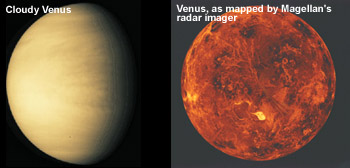 Venus is called the Earth's "sister planet" because its orbit is
closest to Earth, and it has a similar size and density (and thus
gravity) to the Earth's. Its dense atmosphere is highly reflective,
making Venus the brightest object in the sky, after the Sun and the
Moon. On a dark night in a remote location, you can see your shadow -
cast by Venus! Until recently, the rotation period of Venus - Venus's
day - was unknown. The cloud tops have a 4-day period, but Venus
itself rotates with a retrograde motion in 243.1 days. A retrograde
rotation is one that turns in the opposite direction to the direction
of its orbit around the Sun. It takes Venus 224.7 days to orbit the
sun. This makes Venus's "day" longer than its "year"! Another oddity
with Venus is that its "day" is in a 2:3 ratio with an Earth year
(243:356 = 2:3). As a result, when Earth and Venus have their closest
approach, the same side of Venus always faces toward Earth.
Venus is called the Earth's "sister planet" because its orbit is
closest to Earth, and it has a similar size and density (and thus
gravity) to the Earth's. Its dense atmosphere is highly reflective,
making Venus the brightest object in the sky, after the Sun and the
Moon. On a dark night in a remote location, you can see your shadow -
cast by Venus! Until recently, the rotation period of Venus - Venus's
day - was unknown. The cloud tops have a 4-day period, but Venus
itself rotates with a retrograde motion in 243.1 days. A retrograde
rotation is one that turns in the opposite direction to the direction
of its orbit around the Sun. It takes Venus 224.7 days to orbit the
sun. This makes Venus's "day" longer than its "year"! Another oddity
with Venus is that its "day" is in a 2:3 ratio with an Earth year
(243:356 = 2:3). As a result, when Earth and Venus have their closest
approach, the same side of Venus always faces toward Earth.
So, why isn't Venus a great place for humans?
At first glance Venus may seem ideal. But its thick atmosphere makes it
deadly in several ways. The atmosphere of Venus contains chemicals that
combine to spell disaster: CO2SO4 (sulfuric acid),
commonly used on Earth as battery acid. The CO2 in the thick
atmosphere has caused (and may have been created by) a runaway greenhouse
effect, making the temperature at the surface of Venus a lead-melting 750
Kelvin (485º C or 890º F). The pressure caused by the thick
atmosphere is 90 times that of the Earth's pressure at sea level. You
would have to go down one kilometer in the ocean to experience what that
pressure feels like!
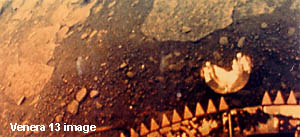
Venus was the first planet to be visited by spacecraft from Earth. The Soviet Venera series of spacecraft landed on the surface in the 1970s and operated for up to 2 hours - enough time to do brief experiments on the composition of the soil and atmosphere and relay a few photos back to the Earth. Then, either the high atmospheric pressure crushed the landers, or their delicate electronics melted.
Since we couldn't view the surface of Venus from orbit or from Earth, and the lifetime of landing craft was so limited by the harsh conditions, we had to resort to another method to map the surface of Venus. In the 1990s, the Magellan spacecraft created detailed radar maps of Venus, mapping 98% of its surface at a resolution better than 100 meters. When the mapping mission was complete, the spacecraft was sent into the atmosphere to gather data. From this mapping we discovered that the surface of Venus is not very cratered - this is because meteors are unlikely to get through Venus's thick atmosphere without disintegrating.
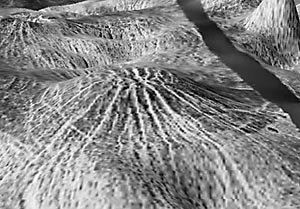 Images of the
Venusian surface like that shown above have been constructed in recent
years by digitally merging distant photographs from height-sensitive
radar. This view shows a 100-km-wide nova (nova are circular hills with
star-shaped fractures). This view is a close-up that shows its fractures
to be grabens or fault bound depressions. Novae may represent an intermediate
stage in coronae formation. Coronae are roughly circular, volcanic
features believed to form over hot upwellings of magma within the Venusian
mantle. Images of the
Venusian surface like that shown above have been constructed in recent
years by digitally merging distant photographs from height-sensitive
radar. This view shows a 100-km-wide nova (nova are circular hills with
star-shaped fractures). This view is a close-up that shows its fractures
to be grabens or fault bound depressions. Novae may represent an intermediate
stage in coronae formation. Coronae are roughly circular, volcanic
features believed to form over hot upwellings of magma within the Venusian
mantle.
|
Venus is not a very attractive place for humans to live. A century ago people wanted to believe that the planet named (rather ironically) for the Goddess of Love was a wonderful place, like a cloudy, moist rainforest, but we now know better. Venus is not for us.
![]()
So We're Off to Mars...
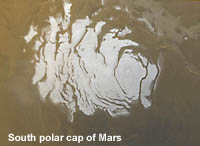 Mars, further from the Sun than Earth, is only about half the diameter of
the Earth and Venus. It has a 24.62-hour day and orbits the Sun in 686.98
Earth days. Mars has a thin atmosphere, containing CO2 and some
H2O. It has much evidence for liquid water in its past, with
vast systems of channels, riverbeds, and canyons that appear very much
like those on the Earth. Mars has seasons, due to the 25º tilt of
its rotational axis (very similar to Earth's 23.5º tilt). In
addition, Mars has polar caps at its north and south poles, made of water
ice and CO2 ice (also known as "dry ice").
Mars, further from the Sun than Earth, is only about half the diameter of
the Earth and Venus. It has a 24.62-hour day and orbits the Sun in 686.98
Earth days. Mars has a thin atmosphere, containing CO2 and some
H2O. It has much evidence for liquid water in its past, with
vast systems of channels, riverbeds, and canyons that appear very much
like those on the Earth. Mars has seasons, due to the 25º tilt of
its rotational axis (very similar to Earth's 23.5º tilt). In
addition, Mars has polar caps at its north and south poles, made of water
ice and CO2 ice (also known as "dry ice").
So, why isn't Mars a great place for humans?
Mars is a much more hospitable place than Venus is, but still has some
drawbacks. Its thin atmosphere is very dry and cold. Daytime highs in
the summer almost make it up to 0º C. The mean temperature on Mars is
-60º C, just a bit warmer than the coldest recorded temperatures on
Earth. Mars's atmospheric pressure is less than 1% of that of the Earth's
at sea level. There is no ozone layer to protect against ultraviolet
radiation. You would need a space suit to survive.
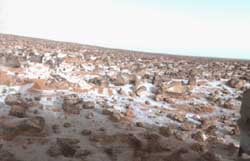
Mars lacks a magnetic field (as does Venus). This may have contributed to the loss of Mars's early atmosphere. The lack of a magnetic field allows "solar wind scavenging," the removal of ions in the upper atmosphere by the solar wind. The observed rates of escape for oxygen ions suggest that the solar wind scavenging process has the potential to remove all of Mars's present inventory of atmospheric oxygen over the next 100 million years. Earth's magnetic field and atmosphere protect it from solar energetic particles released during solar flares and against cosmic radiation. Mars, with its thin atmosphere and lack of magnetic field, has no such protection.
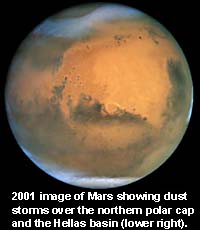 Frequent summer dust storms occur on Mars. A desert dust storm on the
Earth may cover several hundred square kilometers, but dust storms on
Mars are often global in nature, covering much of the surface of the
planet. The surface area of Mars is roughly equal to the land area of
the continents of the Earth. Imagine a dust storm covering all the
continents at once! Dust storms are global on Mars because it is a
desert planet. With no water to damp out the dust, the storm is
self-sustaining. The temperature during Martian dust storms typically
rises by 20º C. The sunlight-absorbing dust can substantially
heat the dry, thin atmosphere - raising winds and, of course, more dust. This
doesn't happen on the Earth, because the temperature of Earth's atmosphere
is regulated by the latent heat of water vapor.
Frequent summer dust storms occur on Mars. A desert dust storm on the
Earth may cover several hundred square kilometers, but dust storms on
Mars are often global in nature, covering much of the surface of the
planet. The surface area of Mars is roughly equal to the land area of
the continents of the Earth. Imagine a dust storm covering all the
continents at once! Dust storms are global on Mars because it is a
desert planet. With no water to damp out the dust, the storm is
self-sustaining. The temperature during Martian dust storms typically
rises by 20º C. The sunlight-absorbing dust can substantially
heat the dry, thin atmosphere - raising winds and, of course, more dust. This
doesn't happen on the Earth, because the temperature of Earth's atmosphere
is regulated by the latent heat of water vapor.
![]()
To the Earth...
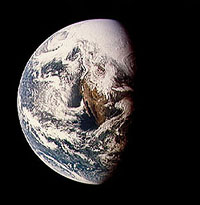 The Earth's orbit is between that of Venus and Mars, allowing an
intermediate amount of sunlight to fall on its surface. The Earth is
unique in the solar system in that it has large amounts of liquid
water on its surface (covering nearly 70% of the surface of the
planet). Its large Moon causes moderate tides, moving nutrient-laden
soil from the continents into the oceans, helping to feed any life
forms that might exist there. There are very few impact craters
visible - only the most geologically recent have not been worn away by
wind and water erosion. Plate tectonics are obvious from the extensive
fault lines, linear mountain ranges and volcanic activity that occur
near major continental edges. The activity associated with the plate
tectonics brings material from the mantle to the surface. The lava
eventually breaks up into a very fertile soil. Volcanic activity also
brings CO2 to the surface, warming the planet. As a planet gets
warmer, its rainfall increases washing CO2 out of its
atmosphere to cool the planet, regulating the greenhouse effect. All of
this happens over periods of several hundred thousand years.
The Earth's orbit is between that of Venus and Mars, allowing an
intermediate amount of sunlight to fall on its surface. The Earth is
unique in the solar system in that it has large amounts of liquid
water on its surface (covering nearly 70% of the surface of the
planet). Its large Moon causes moderate tides, moving nutrient-laden
soil from the continents into the oceans, helping to feed any life
forms that might exist there. There are very few impact craters
visible - only the most geologically recent have not been worn away by
wind and water erosion. Plate tectonics are obvious from the extensive
fault lines, linear mountain ranges and volcanic activity that occur
near major continental edges. The activity associated with the plate
tectonics brings material from the mantle to the surface. The lava
eventually breaks up into a very fertile soil. Volcanic activity also
brings CO2 to the surface, warming the planet. As a planet gets
warmer, its rainfall increases washing CO2 out of its
atmosphere to cool the planet, regulating the greenhouse effect. All of
this happens over periods of several hundred thousand years.
Earth's day is 24 hours long and it takes 365.24 days to orbit the Sun. The tilt of Earth's axis of rotation induces seasons and there are polar ice caps on both poles. Earth's atmosphere is mainly N2, O2, and H2O. These particular gases make it extremely likely that there is life on the Earth: the amount of free oxygen implies that it is being generated somehow, probably by plants.
The oceans of the Earth act as a heat reservoir, storing and moving heat and gases from the tropics to the polar regions and back again. They tend to distribute the heat around the planet, keeping the equatorial regions from becoming too hot and the polar regions from becoming too cold. The water vapor and CO2 present in Earth's atmosphere does this job, too. The atmosphere also contains sufficient levels of ozone to protect any life-forms from intense solar ultraviolet radiation. Studies of the atmosphere in the past few years have shown that the ozone is being depleted at high altitudes over the polar regions. If this trend continues, the surface of the Earth could receive dangerous levels of UV radiation, causing trouble for any life on the planet. The Earth also has a well-developed magnetic field, which protects it from dangerous solar particle events and cosmic rays.
The extremes of surface temperatures on the Earth range from -89.2º C in the south polar region to 56.7º C in a desert region on one of the larger continents in the northern hemisphere. The global mean temperature of the Earth is 14º C, pleasantly above the freezing point of water.
The Earth is clearly habitable for human life, where Mars and Venus are not.
How Big is the Habitable Zone?
The width of the habitable zone for a planet around a star is greatly increased by the existence of a natural "carbon dioxide thermostat" that tends to regulate the temperatures of Earth-type planets, keeping them from getting too hot or too cold for liquid water to exist. The habitable zone in our solar system is quite large. Its inner limit is about 10 million km closer to our Sun, where the oceans would boil off into the atmosphere to be destroyed by the Sun's UV light, allowing CO2 to build up in the atmosphere and turning the Earth into another Venus.If the Earth were located in Mars's orbit, it would have 12,000 times more CO2 in its atmosphere. The thick atmosphere of CO2 would keep the Earth warm enough for liquid water and life. Mars is cold and arid not because it is too far distant from the Sun, but because it's too small to retain its atmosphere.
Recently, meteorologists have found that the clouds of "dry ice" - frozen CO2 - that would form in the upper atmosphere of such a distant high-CO2 world would actually have a further warming effect, so that it might be possible for Earth to be comfortable for life even if it were twice as far from the Sun as it is - as far out as the inner fringe of the Asteroid Belt.
Of course, with all that CO2 in the atmosphere, there wouldn't
be very many sunny days!
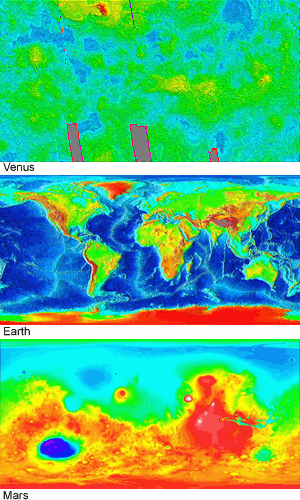 The images at the left are topographic images of Venus, Earth, and Mars.
In the images, blue is low elevation, and red and/or white is high
elevation. Several interesting comparisons can be made. Venus has few
extremes of elevation, most of its surface lying in a 4 km band at Venus'
radius of 6052 km. On the Earth, there are large areas of the surface that
lie up to 5 km below sea level. The land masses often have plateaus or
mountain ranges exceeding 2 km above sea level. Earth has a larger portion
of its surface at the extremes of elevation, compared to Venus. Mars shows
even greater elevation variations, up to 30 km from the lowest point (the
oval shaped area left of center in the southern hemisphere) to the highest
peak (Olympus Mons, the white-peaked circle just to the right of the
center of the image in the northern hemisphere). Another interesting
global feature of Mars is the fact that the northern hemisphere is
generally lower elevation than the southern hemisphere, by about 6 km! The
northern hemisphere is also not as pock-marked with impact craters as the
southern hemisphere.
The images at the left are topographic images of Venus, Earth, and Mars.
In the images, blue is low elevation, and red and/or white is high
elevation. Several interesting comparisons can be made. Venus has few
extremes of elevation, most of its surface lying in a 4 km band at Venus'
radius of 6052 km. On the Earth, there are large areas of the surface that
lie up to 5 km below sea level. The land masses often have plateaus or
mountain ranges exceeding 2 km above sea level. Earth has a larger portion
of its surface at the extremes of elevation, compared to Venus. Mars shows
even greater elevation variations, up to 30 km from the lowest point (the
oval shaped area left of center in the southern hemisphere) to the highest
peak (Olympus Mons, the white-peaked circle just to the right of the
center of the image in the northern hemisphere). Another interesting
global feature of Mars is the fact that the northern hemisphere is
generally lower elevation than the southern hemisphere, by about 6 km! The
northern hemisphere is also not as pock-marked with impact craters as the
southern hemisphere.
